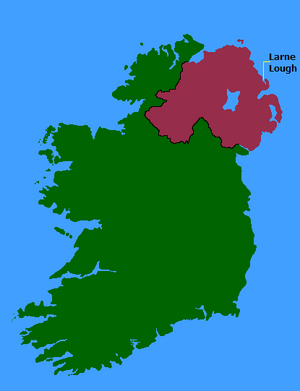Larne Lough facts for kids
Quick facts for kids Larne Lough |
|
|---|---|

Location of Larne Lough
|
|
| Location | Larne, County Antrim, Northern Ireland |
| Coordinates | 54°49′39″N 5°47′24″W / 54.82762°N 5.79011°W |
| Basin countries | Northern Ireland |
| Designated: | 4 March 1997 |
| Reference #: | 895 |
Larne Lough is a sea lough (which is like a narrow inlet of the sea) in County Antrim, Northern Ireland. It's also sometimes called Larne Loch or Lough Larne. The lough sits between a piece of land called Islandmagee and the main part of the country. At its opening to the sea is the town of Larne.
Larne Lough is a very important place for nature. It's protected as an Area of Special Scientific Interest, a special protection area, and a Ramsar site. These special titles help protect the wetland environment. They are especially important for certain bird species and shellfish that live there.
Contents
What's in a Name? Larne Lough's History
The name Larne Lough comes from an old kingdom called Latharna. This name means "descendants of Lathair."
Before that, the lough had older Irish names. These were Loch Ollarbha or Inbhear nOllarbha. These names came from Ollarbha, which was the old name for the Larne Water river.
Exploring Larne Lough's Features
Much of Larne Lough is quite shallow. Over time, it has filled up with fine, muddy sand. When the tide is low, large areas of muddy sand are uncovered, especially in the south.
The northern parts of the lough are wider and deeper. Near the mouth, where ships enter, the area is regularly dug out. This helps keep the shipping path clear for the Larne port.
Long ago, there were natural sandbanks at the lough's mouth. These formed from sand washed in by the sea. However, most of these natural sandbanks are now gone. They were covered by port and industrial buildings. Further up the lough, near Ballycarry, there is a special area called a salt marsh. This is a type of wetland where salty water from the sea mixes with fresh water.
Places to See Around the Lough
The Chaine Memorial Tower lighthouse is a cool landmark. It stands on the west side of the entrance to Larne Lough. Lighthouses help guide ships safely.
Ancient Discoveries: Boats in the Peat
At a place called Ballylig, near Larne Lough, two old dugout boats were found. These boats were buried in peat, which is a type of soil made from decayed plants. Above the peat was marine mud.
Scientists used a method called radiocarbon dating to find out how old the boats were. They found that the boats were made between 3641-3378 BC and 3700-3382 BC. This means they are over 5,000 years old! Both boats were found near the sea lough. There are no big rivers nearby that they could have used. This suggests the boats were likely used for traveling on the sea.
Wildlife and Plants of Larne Lough
In 1929, a study of the algae (a type of plant like seaweed) in northeast Ireland began. Scientists from The Queen's University of Belfast looked at and mapped where different seaweeds grew.
One type of algae they found was Ascophyllum nodosum var. minor. The northern part of the lough was also studied. Today, the plants in the lough are mostly salt marsh communities. There is also a large Phragmites reedbed, which is a type of tall grass. Some areas also have saltmarsh pans, which are shallow pools in the salt marsh.
Larne Lough: A Special Ramsar Site
Larne Lough is a very important wetland area. It is a Ramsar site, which means it's recognized internationally. The site covers about 396 hectares (that's like 978 football fields!). It became a Ramsar site on March 4, 1997.
The Ramsar site is exactly the same area as the Larne Lough Area of Special Scientific Interest and the Larne Lough Special Protection Area. It's special because it helps protect many vulnerable and endangered bird species.
- The lough regularly supports important numbers of breeding roseate terns and common terns. These are beautiful seabirds.
- It also has internationally important numbers of light-bellied brent geese. These geese travel long distances.
- Swan Island, within the lough, has in the past been home to many breeding roseate terns, making it very important for their survival.
The Railway Line Along the Shore
The Belfast-Larne railway line runs right alongside the shore of Larne Lough. You can catch a train from several stations along the lough:
- Larne Harbour
- Larne Town
- Glynn
- Magheramorne
- Ballycarry
The line then crosses a small piece of land connecting Islandmagee to Whitehead railway station. After that, it runs alongside Belfast Lough through Carrickfergus and Belfast Central, ending at Belfast Great Victoria Street railway station.

